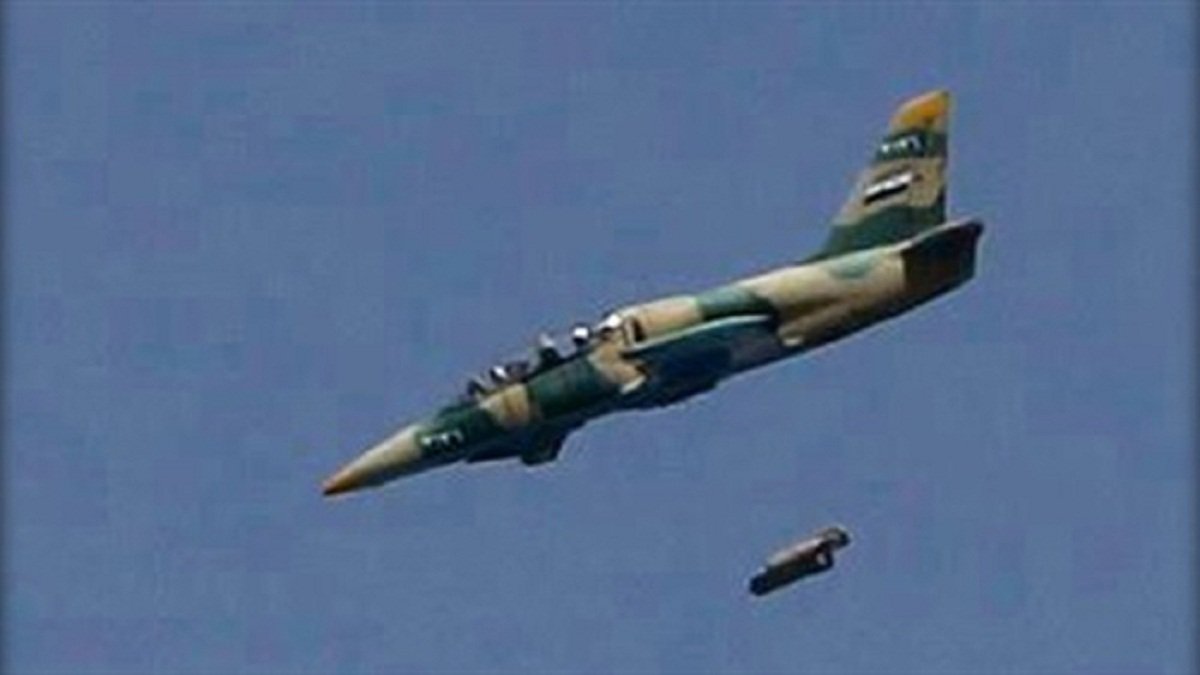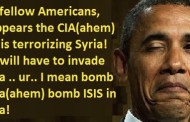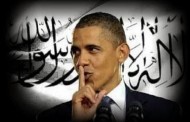Russian And Syrian Warplanes mounted a new wave of air strikes on American backed “Moderate” rebel-terrorist held areas of Aleppo on Saturday, rebel sources, a rescue worker and a war monitor reported, pressing a major offensive by the Russian-backed Syrian military.
Speaking to Reuters from Aleppo, Ammar al Selmo, the head of Civil Defence in the opposition-held east, said: “Unfortunately it continues. There are planes in the sky now.”
The Britain-based Syrian Observatory for Human Rights Director Rami Abdulrahman told Reuters: “The raids are intense and continuous.”
Residents of rebel-held eastern Aleppo said it faced the most ferocious bombardment of the war on Friday, after the military declared a new offensive to take back full control of the divided city. Selmo said the death toll was now over 100.
The Observatory said its death toll was 47.
********************** MORE INFO ON RUSSIAN AND SYRIAN AIR STRIKES ON U.S. BACKED TERRORISTS !
Syrian and Russian warplanes launched a ferocious assault against American backed terrorist rebel-held Aleppo on Friday, burying any hopes that a U.S.-backed cease-fire could be salvaged and calling into question whether the deal would ever have worked.
Waves upon waves of planes relentlessly struck neighborhoods in the rebel-held east of the city on the first day of a new offensive announced by the government. Residents described the most intense airstrikes they had yet witnessed in a five-year-old war that has already claimed in excess of 300,000 lives.
By nightfall, more than 100 bombs had landed, and more than 80 people were dead, said Ammar al-Selmo, head of the Aleppo branch of the White Helmets civil defense group.
Amateur video purports to show the aftermath of Syrian government air strikes in the al-Ansari neighborhood of Aleppo, some of the heaviest strikes yet on rebel-held areas. (Reuters)
“People don’t know what to do or where to go. There is no escape. It is like the end of the world.”
If there had been any doubt before that the cease-fire deal co-sponsored with Russia is dead, at least for the foreseeable future, the violence Friday put it to rest. A meeting in New York between Secretary of State John F. Kerry and Russian Foreign Minister Sergei Lavrov ended swiftly, without statements or discernible progress toward Kerry’s stated goal of reviving last week’s cease-fire.
Instead, the launch of the offensive called into question the entire premise of the agreement painstakingly negotiated by Kerry and Lavrov over the past eight months: that Russia shares the Obama administration’s view that there is no military solution to the conflict. On that basis, U.S. officials have explained, Moscow would be willing to pursue a negotiated settlement in return for a cease-fire and the prestige of eventually conducting joint military operations in Syria alongside the United States against terrorist groups.
[How the Syrian revolt went so horribly, tragically wrong]
At a news conference in New York, Lavrov offered a starkly different point of view. He said it is the United States that needs to come around to the idea that President Bashar al-Assad is the only viable partner in the fight against terrorism, calling his army “the single most efficient force fighting terror in Syria.”
“Little by little, life will make everyone understand that it’s only together that you can fight terrorism,” Lavrov said.
His comments, alongside the events of the past week, suggest that Russia and Syria still believe the war can be won outright, without recourse to negotiations that the United States has said offer the only way out of the Syrian tragedy.
The latest cease-fire in Syria lasted only six days before the warplanes returned to the skies above Aleppo. Eyewitness accounts claim that white phosphorus munitions were dropped on the city on September 20. The incendiary weapon burns at extreme temperatures. (TWP)
A U.S. strike against a Syrian army position in the east of the country last Saturday exposed the deficit of trust between the two parties to the deal, with the Pentagon insisting it was a mistake but Russia accusing the United States of collaborating with the Islamic State.
But the deal may have been doomed before that, by conflicting interpretations of the war on the ground. Assad has repeatedly expressed his intention to reconquer all of Syria from the rebels he uniformly calls “terrorists,” and he reiterated that determination on the eve of the cease-fire.
Days before the truce took hold, the assortment of Iraqi militias, Hezbollah fighters, government militias and Syrian army troops finally completed the encirclement of rebel-held Aleppo, after months of fighting and hundreds of casualties that included several senior Iranian officers fighting alongside regime forces.
“The Russians were eventually seeing progress in their strategy without any cease-fire. The regime’s military situation was improving. Assad’s position was solidifying. Russia’s strategic goals in the region were being met,” said Jeff White of the Washington Institute for Near East Policy. “There was no compelling reason for them to push hard for a cease-fire. The person pushing hard was Kerry, but the Russians were sort of, ‘Meh, we can take it or leave it.’ ”
Iran’s support has proved as instrumental as Russia’s in shoring up Assad’s hold on power, with Iranian-trained and -funded Shiite militias from Iraq and Afghanistan, as well as Lebanon’s Hezbollah, reinforcing the depleted Syrian army on most of the important front lines.
Whether Russia ever would have been able to persuade Assad to comply with the deal is in question, said Robert Ford, who served as U.S. ambassador to Syria during the earliest years of the uprising against Assad and is now with the Washington-based Middle East Institute. It is also far from clear whether the United States would have been able to sell the fractious rebels on a deal that would have required them to separate from extremists, he said.
“Both the U.S. and Russia overestimated the other side’s leverage,” he said.
An attack on a U.N. aid convoy Monday — by Russian warplanes, according to the Pentagon, though Russia has denied any involvement — suggested that Russia’s military also was in no mood for a deal that would halt the war just when it was going Assad’s way.
The attack puzzled many in Moscow who thought that Russia wanted the deal, said Vladimir Frolov, a foreign affairs columnist for the Moscow Times. But, he said, it now appears that Russia is “leaning towards the view that this war is winnable.”
“Realistic people realize that this is not possible, but some people are unrealistic,” he added.
Whether the war can be won is in question. Vast areas of the country have fallen out of government control. The north and northeast are now controlled either by Kurds allied with the United States or by the Islamic State, which no one disputes should be vanquished by force.
But those areas are sparsely populated, consist mostly of desert and — although they contain small quantities of rapidly depleting oil — do not rank as vital to Assad’s continued hold on power in Damascus, the capital.
The war for control of the Islamic State-held parts of Syria has been less of a priority for the government and Russia than the one to recapture the rest of the country, which Assad supporters call “the useful Syria” because it is where most of the population lives. There, the battles have been going mostly Assad’s way.
Russia’s dispatch of troops and warplanes a year ago has worked to secure the regime’s grip on the capital and to reverse or halt rebel gains in the north and the south.
Meanwhile, communities that had held out against government forces for years have been gradually surrendering, most recently al-Waer, the last neighborhood of the once-rebellious city of Homs to give up the fight.
Aleppo remains an exception, an important urban center that the government was unable even to encircle until this month. Before rebel fighters overran the eastern portion of the city in the summer of 2012, it was Syria’s biggest metropolis, with a population of 3 million, and the epicenter of the country’s industry and trade. As long as the rebels have a presence there, they can claim a stake in the future of Syria — but without it, their revolt against Assad’s rule becomes a rural insurgency contained within the country’s border provinces, diplomats say.
Any battle for Aleppo would be bloody and long. An estimated 250,000 people are trapped there, far more than in any of the other communities, and the rebels have had four years to dig in and reinforce their positions. It could become the next bargaining chip in any negotiations that may take place between Moscow and Washington.
“I could imagine the regime retaking Aleppo eventually,” Ford said. “The direction of the battle is glacial, but it is only going in one direction.”
- Будь в курсе последних новостей и интересных статей, подписывайся на наш канал «NovorossiaToday»
- Be aware of the current events and interesting articles, subscribe to our channel «NovorossiaToday»
- Pour ne rien manquer de la derniere actualite et des articles interessants, suis notre chaine Telegram en direct«NovorossiaToday»







